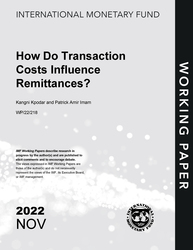
How Do Transaction Costs Influence Remittances
How Do Transaction Costs Influence Remittances
READ MORE...
Volume/Issue:
Volume 2022
Issue 218
Publication date: November 2022
ISBN: 9798400224270
$20.00
Add to Cart by clicking price of the language and format you'd like to purchase
Available Languages and Formats
| English |
Prices in red indicate formats that are not yet available but are forthcoming.
Topics covered in this book
This title contains information about the following subjects.
Click on a subject if you would like to see other titles with the same subjects.
Banks and Banking , Exports and Imports , Economics- Macroeconomics , Economics / General , Emigration and Immigration , Remittances , Transaction Costs , Elasticity , Migration , elasticity of remittance , remittance market , remittances flow , remittance cost , cost-mitigation factor , Income , Exchange rates , Correspondent banking , Global
Summary
Using a new quarterly panel database on remittances (71 countries over the period 2011Q1- 2020Q4), this paper investigates the elasticity of remittances to transaction costs in a high frequency and dynamic setting. It adds to the literature by systematically exploring the heterogeneity in the cost-elasticity of remittances along several country characteristics. The findings suggest that cost reductions have a short-term positive impact on remittances, that dissipates beyond one quarter. According to our estimates, reducing transaction costs to the Sustainable Development Goal target of 3 percent could generate an additional US$32bn in remittances, higher that the direct cost savings from lower transaction costs, thus suggesting an absolute elasticity greater than one. Among remittance cost-mitigation factors, higher competition in the remittance market, a deeper financial sector, and adequate correspondent banking relationships are associated with a lower elasticity of remittance to transaction costs. Similarly, remittance cost-adaptation factors such as enhanced transparency in remittance costs, improved financial literary and higher ICT development coincide with remittances being less sensitive to transaction costs. Supplementing the panel analysis, the use of micro data from the USA-Mexico corridor confirm that migrants facing higher transaction costs tend to remit less, and that this effect is less pronounced for skilled migrants and those that have access to a bank account.
Copyright © 2010 - 2025
Powered by:
AIDC



